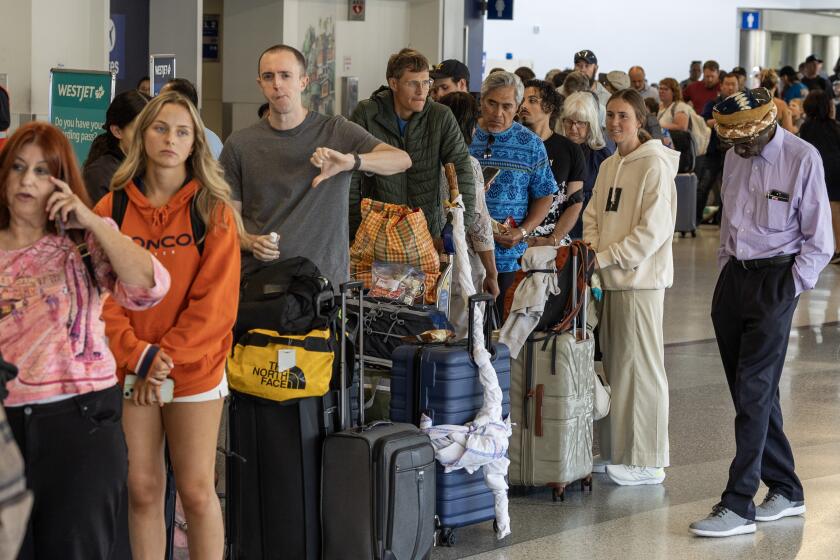The Valley According to Crespi : History: New translation of the Franciscan missionary’s diary of the Portola expedition offers a richly detailed picture of life in 1769 California.
On Aug. 5, 1769, a short, pale Franciscan missionary named Juan Crespi looked northward from about where Mulholland Drive now spans the San Diego Freeway, across the San Fernando Valley, then a trackless bowl of wild grass dotted here and there with oak and sycamore trees.
Crespi, dressed in the traditional gray habit of the Franciscans and probably riding his red mule, Sonora Gal, described the sprawling Valley in his journal as “vastly lush” and remarked prophetically that its natural springs and “dark, friable” soil made it an ideal spot to build a town.
As the diarist for the first European expedition to explore uncharted California, Crespi made observations that have long provided scholars and history buffs with a portrait of the region modern residents can only imagine. It was a world without freeways or smog or traffic jams, a world where the huts of Indian villages occupied some of what is now prime real estate in Encino and Westlake Village.
Recent translations of the friar’s original handwritten journal--long considered lost--provide new details that experts in California history say will be invaluable in reconstructing the first expedition, including its march through the San Fernando and surrounding valleys. The route they took eventually became El Camino Real, the main route between Northern and Southern California.
“Here you have the opportunity to hold somebody’s hand and walk with them,” said Sam Mayo, acting dean of academic affairs at Los Angeles Valley College and former history professor. “It gives you a real sense of what it was like.”
Crespi was part of an expedition sent north from Mexico in 1769 under Gaspar de Portola to rediscover the fabled Monterey Bay as a way of checking Russian expansion into Northern California. The bay had been discovered a century earlier but had not been visited by the Spaniards since.
Charged by the Spanish governor with scouting mission sites and recording “the good, the bad, and even the indifferent,” Crespi was one of two Franciscan missionaries in a party of 61 soldiers.
The party left San Diego on July 14, 1769, and marched easily north through modern Orange County and downtown Los Angeles to modern-day Westwood. Camped near what is now the Veterans Administration Hospital in Westwood, scouts at the evening meeting of Aug. 4, 1769, reported seeing the Pacific Ocean about five miles away.
The next morning, Portola sent them west to find a route north along the coast, but the scouts recommended against going up the coast because it would have been difficult for the expedition’s horses and mules to negotiate the sheer cliffs of the Pacific Palisades.
So Portola opted instead to look for an inland route, and the party trekked across the Santa Monica Mountains through the Sepulveda Pass. In the early afternoon of Aug. 5, 1769, the party headed roughly up the path of Sepulveda Boulevard.
A historical marker at the corner of Sepulveda and Moraga Drive commemorates the route.
“We set out a little past 2 o’clock in the afternoon,” Crespi wrote. The hills “are quite high and rather steep; however, very much covered with a great deal of grass (I have seen none better anywhere) and the hollow which we were following much lined with large sycamores, live oaks and white oaks and also with a great many small walnut trees laden with quantities of small round nuts with very good meat, only their shells are quite thick and hard to crack; and a great many rose bushes.”
Crespi’s original name for the valley before him was Santa Catalina de Bononia, celebrating the day of St. Catherine of Bologna. Crespi’s names, almost always corresponding with saint’s days, generally have not survived.
Descending from the top of the pass into the Valley--probably about 5 p.m.--Portola and his men found a few Indian villages scattered along the base of the mountains in present-day Encino. They stopped at one, believed to be the “Lost Village of Encino,” and set up camp near the warm pool at what is now the Los Encinos State Historical Park near the intersection of Ventura and Balboa boulevards.
Crespi wrote: “. . . We set up camp beneath a large live oak upon the south side of the valley, here close to a very large pool of very pure water at the foot of the mountain range on this side; where we came upon two large villages of very fine, well-behaved and very friendly heathens who must have amounted to about 200 souls, men, women and children.”
Earlier versions of Crespi’s journal delete many of his references to how the Indians lived, but the new translations include detailed descriptions about daily life in the Indian villages encountered by the expedition.
“We began to meet with regular houses here at this spot, and they have some underground ones that are very large, being like a sort of porticoes within and with a small doorway like a chimney hole through which they go in and out to protect themselves from the cold,” Crespi wrote. “Their lives are governed a bit, at all of the villages there being three or four chiefs, with one chief who is head of all the others and gives them orders, as they do the rest of the people, and are very easily obeyed, or so we understood.
“Here also we began to see very well-carved flutes that they play on. We understand from these heathens that they each have only a single wife with the exception of their chiefs, who have two.
“Indeed, these heathen folk have pleased us a great deal, having been (as they have) spending the whole day sitting with us, entirely without weapons or fear, as though they had been dealing with us forever.”
Those types of entries, experts said, tend to undermine current perceptions that early European explorers were cruel and casually exploited California Indians. They acknowledged that Indian society ultimately was destroyed by European incursions, but early encounters were peaceful, not violent.
“That doesn’t fit the picture that people try to portray now,” said Harry Kelsey, retired curator of history for the Los Angeles County Museum of Natural History and a researcher at the Huntington Library in Pasadena. “The Indians were glad to have the missionaries around. They had goods the Indians had never seen before, and the missionaries showed them how to do things more efficiently.”
After a day of rest beside the Encino pool, the expedition headed north roughly along the path of the San Diego Freeway, camped overnight near Van Norman Reservoir, and climbed into the Newhall Pass, where the concrete columns of the Golden State and Antelope Valley freeways now tower above what was once chaparral and steep slopes. The men climbed into the Santa Clarita Valley, where they found several more Indian villages.
“Shortly after coming into this hollow we were met by three more heathens, sent by their chief from the village,” Crespi wrote. “Soon we caught sight of the whole village, awaiting us while encamped in the shade of some trees. (The scouts had come here yesterday, when the heathens of this village presented them with a great deal of seeds, gruel, and very well flavored small raisins.) One of their chiefs, at our arrival, was making a long speech.”
The next day, Aug. 8, 1769, the expedition turned west along the Santa Clara River and headed toward present-day Ventura. From Ventura, the route headed north and hugged the coastline, except near the sheer cliffs of Big Sur, where the expedition was forced inland up the Salinas Valley.
Two months later, in October, 1769, the expedition discovered San Francisco Bay, overshooting its goal of Monterey by about 100 miles. Running short on food and afraid they would miss their supply ship at Monterey, the expedition members began their return trip a few days later.
Upon reaching Ventura, the expedition decided against retracing its northward route along the Santa Clara River and opted instead to trek through what is now Thousand Oaks and followed various mountain passes to present-day Westlake Village.
Tired and hungry, Crespi devoted little attention to his diary during this final stretch of the trip. His descriptions of it are brief, not nearly so elaborate as earlier entries, and stick almost strictly to directions and topographical features.
While the officers of the party shared food with Crespi and Father Francisco Gomez, the rest were forced to kill and eat the expedition’s mules every third day, according to the journal.
On Jan. 14, 1770, the party stopped at a village near Mainsail Circle and Triunfo Canyon Road on what now are the exclusive shores of Westlake, then just a stream. Portola Lane and Crespi Lane are private streets about three blocks away.
Archeologist Chester King said the remains of this village--called Hipuc--were dug up and destroyed in 1966 when Westlake Village was developed. Crespi named the area El Triunfo del Dulcisimo Nombre de Jesus, or the Triumph of the Most Sweet Name of Jesus, one of the few place names that survive.
The next day, the party wound through confusing terrain until it came to a Chumash village near Kanan Road and Thousand Oaks Boulevard in Agoura Hills, now the site of a grocery store and neighborhood shopping center. Lost, the party members picked up Indians who guided them onto the western edge of the San Fernando Valley, about where the Ventura Freeway cuts along the southern edge of Calabasas.
Valley College history professor Dave Brown speculated that the expedition may have come within a few hundred yards of the south gate of Hidden Hills and then stopped for lunch near what is now the Sagebrush Cantina at Calabasas Creek, described by Crespi as “a small stream with a great deal of willow, sycamore and live oak trees.”
After lunch, the party marched roughly along Ventura Boulevard to the pool at Los Encinos, where the men camped for the night. The next morning, they set out toward Burbank and climbed over the Cahuenga Pass into modern Hollywood.
They reached San Diego on Jan. 24, 1770.
More to Read
Sign up for Essential California
The most important California stories and recommendations in your inbox every morning.
You may occasionally receive promotional content from the Los Angeles Times.






